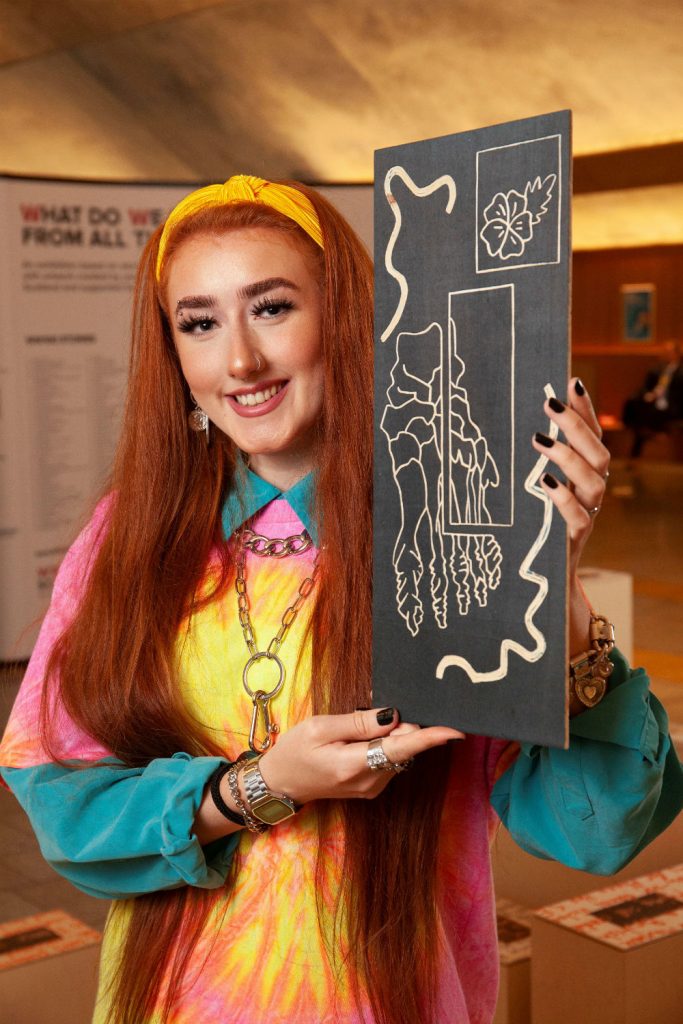One hundred stories of Scotland’s WW1 – told through the perspective of 100 young artists – feature in an innovative new installation launched today at the Scottish Parliament which will be on display until Friday 20 September before touring Scotland.
Entitled “What Do We Learn From All Th1s?” the exhibition, commissioned by the Scottish Government, delivered by research and design collective Lateral North and facilitated by the Scottish Print Network, uses traditional print making techniques combined with innovative technology. It displays the matrices used to develop each of the artists’ 100 unique prints on wooden plinths arranged in a map of Scotland. Augmented reality technology enables visitors to explore each of the stories in detail with an iPad.
From individual acts of valour on the battlefield to naval tragedies off Scotland’s coast, from the thousands of workers filling factories at home to the brave members of the Scottish Women’s Hospitals at the Western Front, from innovations in areas such as surgery and aviation to the enduring work of poets and artists in the trenches, the project takes in a wide range of stories and subjects that will resonate throughout Scotland.
Five print studios in Aberdeen, Dundee, Edinburgh, Glasgow and Inverness, with artists from 14 years of age upwards, contributed to the project which marks the culmination of Scotland’s WW1 centenary programme.
City of Glasgow College student Tiegan Murray’s print tells the story of Helensburgh inventor John Logie Baird, famous for inventing the television, who developed ‘The Baird Undersock’. Deemed unfit for military service when he tried to enlist in 1914, one of Logie Baird’s ailments was constant cold feet. The Undersock he developed helped keep the soldiers feet in good health.
Fifteen year old Trisha Shenoy who is studying at The International School of Aberdeen, depicted ‘Maconachie’s Stew’, a familiar aspect of the British soldier’s diet in her piece. One account from the time describes the stew as “warmed in the tin, Maconochie’s was edible. Cold it was a man-killer.”
Highly successful Scottish singer and entertainer Sir Harry Lauder who toured the world for four decades, and was described by Sir Winston Churchill as “Scotland’s greatest ever ambassador”, formed the focus for student Lola Knibb of Duncan of Jordanstone College of Art & Design in Dundee.
She commented: “My piece tells the story of Sir Harry Lauder’s journey during the war where he campaigned for war efforts and promoted recruitment into the services. He did this through the means of entertainment and music and he can be seen leading a parade of troops out of the city of Edinburgh, keeping the spirits high with music and marching, wearing his full highland attire which he became known for popularising on his tours around the world. The knobbly walking stick became one of Lauder’s most iconic features and he took one with him everywhere he went.”
The print by Christina MacKenzie, a third year student at Inverness High School, tells the tale of two guests at the Royal Highland Hotel in Inverness (then the Station Hotel) who were uncovered as spies. The pair – a man and a woman – were arrested and taken to London to be tried. Some of the hotel’s staff were called to give evidence against them. The man ended his career in the Tower while the woman was sentenced to penal servitude for life.
Edinburgh’s Scottish National War Memorial is the focus for Eilidh Muldoon, a graduate and teaching fellow from Edinburgh College of Art. The memorial was established by Royal Charter to commemorate the sacrifice of Scots in WW1 and opened in 1927.
Commenting on her work, Eilidh, said:
“When I visited the Scottish National War Memorial I was immediately drawn to the intricate detail in the decorative stained-glass windows. I discovered that the decorations to the North, East, South and West of the building were designed to pay homage to those who fought and lost their lives in the war, but also to the experiences of those left at home.

The free exhibition at the Scottish Parliament was welcomed by Presiding Officer Rt. Hon. Ken Macintosh MSP, who said:
“One hundred years on from the First World War, the scale of the devastation and loss of life resulting from this horrific conflict continues to move people, and in this case, to touch and inspire a new generation of young artists.
“It is worth remembering that so many of the Scots who lost their lives a century ago were the same age as the artists contributing to a wonderful installation which explores and re-tells their stories. I have no doubt that this artwork will make an impact on all who take the time to visit.”
Fiona Hyslop, Cabinet Secretary for Culture, Tourism and External Affairs, said:
“The ‘What Do We Learn From All This?’ project is a fitting culmination to the WW100 Scotland commemorations, allowing young people from across Scotland to tell the stories of World War One through the medium of print. It is particularly appropriate that the artworks harness traditional print-making techniques with augmented reality, bringing together old and new.
“World War One affected every village, town and city in Scotland, touching the lives of millions. It is important that we continue to remember the stories of bravery and sacrifice and to ensure they are passed on. I hope that many people will visit the Scottish Parliament to see the installation and to reflect on the artworks and the stories behind them.”
Tom Smith, director at Lateral North, said:
“We have been working with students from across Scotland to creatively interpret people and place based stories of the First World War. Working with Solius Heritage and the Scottish Print Network, we have brought over 100 artworks together in the form of an abstract map of Scotland. These stories are revealed in augmented reality bringing the Century old stories into the present day.”

